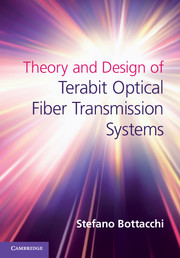Book contents
- Frontmatter
- Dedication
- Contents
- Preface
- Acknowledgments
- Part I Signals, spectra and optical modulations
- Part II Principles of light polarization and optical amplification
- 4 Principles of non-linear optics and light polarization
- 5 Principles of light amplification
- 6 Spectral gain modeling of optical amplifiers
- 7 Noise theory of optical amplifiers
- Part III Interferometric optical modulators
- Part IV
- Appendix A Electromagnetic energy and power flow
- Appendix B Optical power and photon flux
- Index
- References
6 - Spectral gain modeling of optical amplifiers
Spectral effects and non-linear distributed gain in the optical amplification medium
from Part II - Principles of light polarization and optical amplification
Published online by Cambridge University Press: 05 September 2014
- Frontmatter
- Dedication
- Contents
- Preface
- Acknowledgments
- Part I Signals, spectra and optical modulations
- Part II Principles of light polarization and optical amplification
- 4 Principles of non-linear optics and light polarization
- 5 Principles of light amplification
- 6 Spectral gain modeling of optical amplifiers
- 7 Noise theory of optical amplifiers
- Part III Interferometric optical modulators
- Part IV
- Appendix A Electromagnetic energy and power flow
- Appendix B Optical power and photon flux
- Index
- References
Summary
Introduction
In this chapter we will present the theory of spectral gain in optical amplifiers and the related optical power distribution. The concepts are general, as they apply to every optical amplifier configuration, independent of the specific architecture and implementation technology. We will configure the optical amplifying medium as a traveling-wave device, where the optical field undergoes optical amplification as it propagates from the input to the output sections. Generally speaking, optical amplification is achieved by a net stimulated emission process. Referring to a generic section z of infinitesimal thickness dz, optical gain is determined by the imbalance between net stimulated emission and cavity losses, including extrinsic absorption, reflection and radiated fields. As we know from the theory of light amplification in the three-level atomic system presented in Chapter 5, stimulated absorption of photons is governed by the same transition rate as stimulated emission, and is included in the net stimulated emission process. With this in mind, we note the identity between stimulated emission and the stimulated absorption rates, Γ12 = Γ21, and the net stimulated photon term Γ[j2(t) – j1(t)]p(t) in the rate equation. In order to develop the traveling-wave model, the photon density becomes a function of the longitudinal position 0 ≤ z ≤ L along the amplifier medium. Accordingly, we will set p(t,z) as the relative density of stimulated photons per unit volume (0 ≤ p(t,z) ≤ 1) at time t and section z. When photons with appropriate energy proceed along the amplifying medium, they are amplified by means of net stimulated emission. At some section z = z0, the steady-state photon density P(z) can approach the saturation density Psat(z).
- Type
- Chapter
- Information
- Theory and Design of Terabit Optical Fiber Transmission Systems , pp. 374 - 432Publisher: Cambridge University PressPrint publication year: 2014



